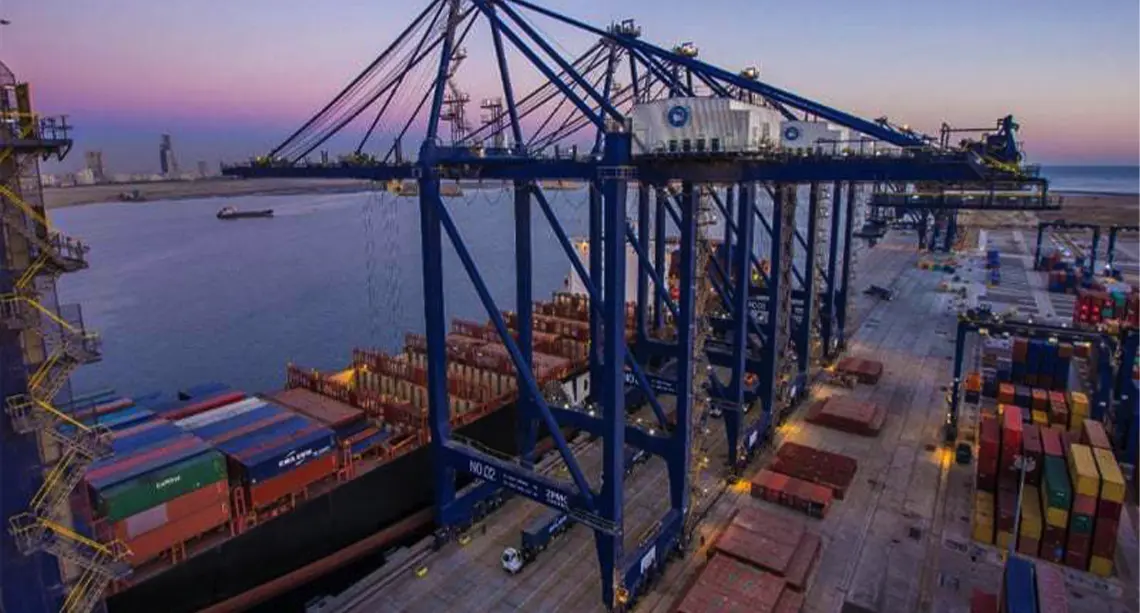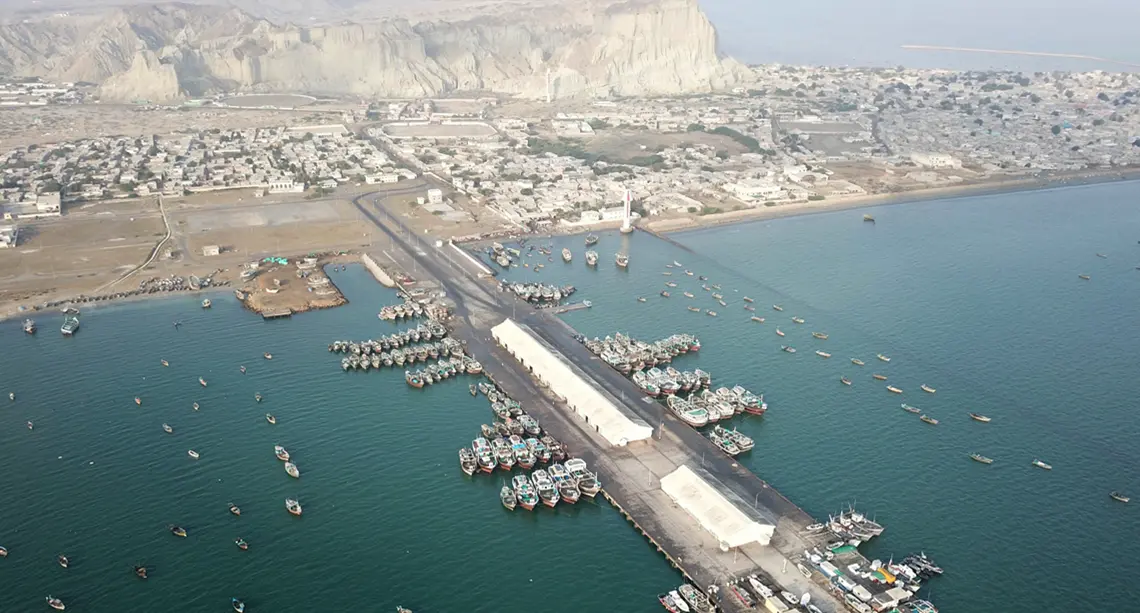An overview of Pakistan’s ports and harbours gives an insight about how far the country is from reaching its full maritime potential.
A port is a maritime facility comprising wharves where ships are docked for cargo loading/unloading and disembarking of passengers. Ports are situated on coastlines and have close connectivity with the sea. There are different types of ports including cruise ship ports for passenger ships, dry ports connected by road or rail, fishing ports and inland ports linked to river or canal. A port is different than a harbor in such a way that harbors are mooring places for safe anchorage of ships and other waterborne vessels, whereas ports are completely different commercial water facilities comprising warehouses, docks and cranes that connect land to the sea for cargo handling and passengers’ transportation. Ports are vital transportation hubs that provide facilities for the movement of goods from local markets to worldwide markets.
Ports are considered vital for supporting the economic life of any country. Ports do not only serve the purpose of cargo handling but also bring about local economic well-being. Economy of a country relies heavily on seamless trade and cargo facilitated through ports which serve as gateways for domestic and international trade. Countries which have developed and modernized ports such as Singapore and Dubai are enjoying better trade and transportation systems in terms of more economic dividends. Moreover, industrial development is closely tied with ports as industries need a cheap and safe means for exporting finished goods to and importing raw material from the desired destination. Here comes the role of ports which augment economic activities being carried out at land by expanding the volume of international trade and connecting different economies via sea. Besides, ports also create job opportunities for local people and supplement infrastructure development in the vicinity that also add up to more job and business opportunities. Therefore, ports have an important role to play in a nation’s economic growth.
Pakistan is blessed with the 1046 kilometer coastline along the Arabian Sea. The coastline is divided into Makran Coast spreading over 800 kilometers and Sindh Coast extending up to 246 kilometers. Pakistan, so far, has developed three big ports namely Karachi port, Gwadar port and Muhammad Bin Qasim port. Muhammad Bin Qasim port or Port Qasim is one of the oldest ports of Pakistan whereas Karachi port is the busiest among all. Gwadar port with significant geostrategic location has been lately developed by Pakistan in collaboration with China. Gwadar port is one of the deepest sea ports in the world and can accommodate up to a sixteen meter deep cargo ship. Pakistan’s geography is strategically significant given its connectivity with different regions including Western China, Afghanistan and Central Asian Republicans such as Turkmenistan, Tajikistan, Kazakhstan and Uzbekistan. Hence, all the above mentioned ports hold strategic importance for the country. These ports have their own administrative units. However, Ministry of Maritime Affairs being the central administrative authority is mandated to facilitate and administer the development of port and the shipping industry of Pakistan. When it comes to the admiralty jurisdiction, these ports fall under the jurisdiction of Sindh and Baluchistan High Courts by virtue of the Admiralty Jurisdiction of High Court Ordinance, 1980.

Karachi Port:
Karachi port is one of the largest ports in South Asia and the busiest port of Pakistan. This port is considered to be an economic hub of Pakistan dealing around sixty percent of the nation’s cargo. Karachi Port is a deep natural port with an 11.5 km-long navigable channel and a 12.2 meter-deep approach channel. The port has 30 dry cargo and 3 liquid cargo handling berths including a privately operated modern container terminal – the Karachi International Container Terminal (KICT). The port is handling about 26 million tons of cargo per annum which includes 14 million tons of liquid and 12 million tons of dry cargo. Presently about 1600 ships are visiting Karachi Port annually and the berth occupancy is about 45%, which shows that there is enough capacity in the port to handle more cargo.

Gwadar Port:
Gwadar port is the most discussed port among policy makers, media and academia in recent times. This is the deepest sea port of Pakistan and lies at the distance of 400 kilometers from the Strait of Hormuz and 120 kilometers from Iran’s border. The Strait of Hormuz is one of the primary channels in the world for global trade and oil supply. Thus being strategically important for both China and Pakistan, Gwadar port is undergoing rapid development as part of the China Pakistan Economic Corridor.

Port Qasim:
Port Qasim is the second busiest and deepest sea port of Pakistan. The Port is situated in the Indus delta region at a distance of 28 nautical miles in the south-east of Karachi. It has a 49 km long navigational channel and currently handles more than 40% of seaborne trade of the country. With a cargo handling capacity of about 17 million tons annually, it is the second busiest port of Pakistan. Large vessels having 13 meter draught and 347 meter length are handled at this port.
PAKISTAN IS BLESSED WITH THE 1046 KILOMETER COASTLINE ALONG THE ARABIAN SEA. THE COASTLINE IS DIVIDED INTO MAKRAN COAST SPREADING OVER 800 KILOMETERS AND SINDH COAST EXTENDING UP TO 246 KILOMETERS. PAKISTAN, SO FAR, HAS DEVELOPED THREE BIG PORTS NAMELY KARACHI PORT, GWADAR PORT AND MUHAMMAD BIN QASIM PORT
Other than major ports, Pakistan also has some smaller ports which are discussed below:
Keti Bander Port:
Keti Bander port is located in the Thata district of Sindh. This port is around 150 kilometers away from Karachi and is yet to be developed into a major port under the Pakistan China Economic Corridor project. Keti Bander once a vast area of crops including banana, rice, and betel leaf is facing decreased water level in the Indus River and thus the residents are completely dependent on fishing for living.
Ormara Port:
Ormara port is located on Makran coastline in Baluchistan. This port is also considered strategically important as one of the most strategically important naval bases of Pakistan – Jinnah naval base – is located there. This port is also considered rich for fishing and has also been linked with the China Pakistan Economic Corridor through the coastal highway of Makran.
Pasni Port:
Pasni port is also located along the coastline of Makran in Baluchistan at a distance of around 300 kilometers away from Karachi. This port is also under development following the decision of the Pakistan government to augment cargo activities there by connecting it with China Pakistan Economic Corridor to make it fully commercial. Pasni has a fully operational airfield which is used by Pakistan Air Force, Pakistan Navy and Civil Aviation.
Jiwani Port:
This port is strategically very important as it adjoins the delivery lanes from and to the Persian Gulf. Owing to its strategic location, this town hosts an airport which has a 5600-foot runway and a small naval base.